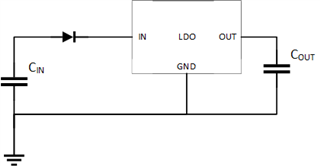Other Parts Discussed in Thread: TPS7A37
Hi,
I have read all the posting in https://e2e.ti.com/ regarding this issue but could not find a proper solution to it.
What we understand is the need for a reverse bias diode connecting between Vin and Vout in order to protect the internal body diode of the LDO in the event when Vin << Vout. This is often the case for many situation since the preceding stage could well be a DC/DC with quick discharge enabled. However, since the body diode of the LDO is not characterized and stated in datasheet, it will be impossible to make educated selection of the external diode.
In many of the posting, the only advice provided is to select schottky diode due to its low forward voltage. However, this parameter is affected by the forward current and the ambient temperature. An increase of ambient temperature from 25C to 70C usually increase the forward voltage of a schottky diode to >0.7V. Would this result in having the external diode not being activated when Vin < Vout? It will be critical for TI to assist us on making this decision.
In our circuit, we have also noticed the external diode causing the Vout to increase in tandem with the ambient temperature.
For example, suppose your LDO circuitry has Vin =15V, Vout=3.3V with Iout=5mA, the output will rise to 3.5V and above as the ambient temperature goes above 70C. This is due to the reverse current of the external diode. Higher ambient temperature increases the reverse current of the external diode.
As such, we will have to find a diode with extremely low reverse current (range <10uA), low forward voltage (<0.4V) while being able to accept high pulsed forward current across temperature. Could TI assist us in shortlisting such a diode? Or would TI be able to at least provide a hard figure on the internal diode forward voltage?
Many thanks.
Best rgds,
KLP


